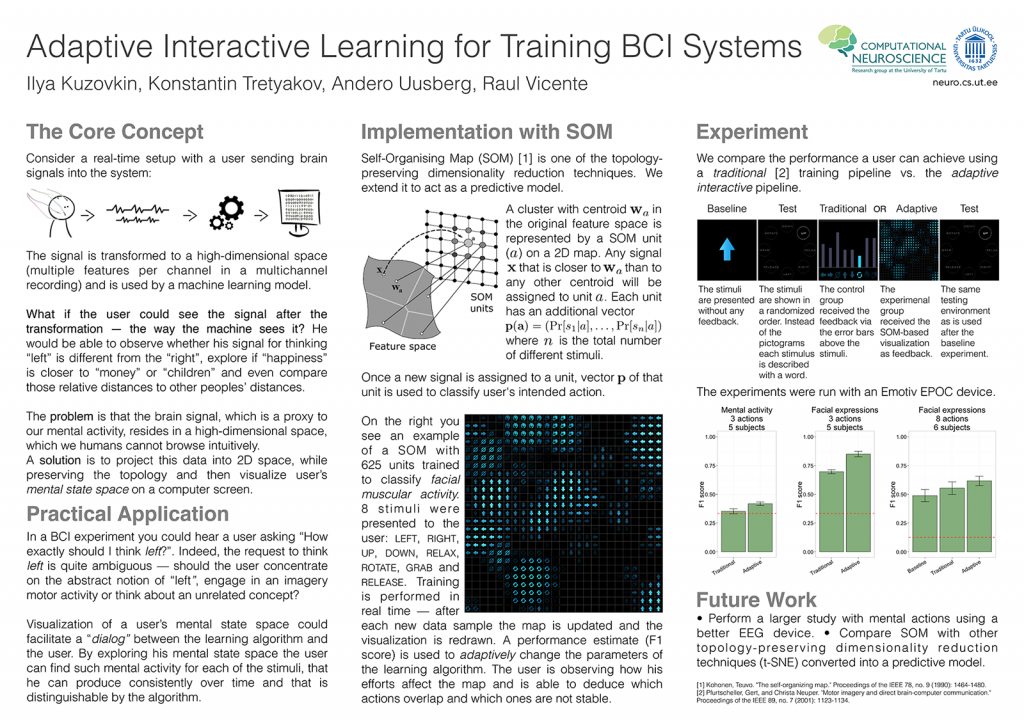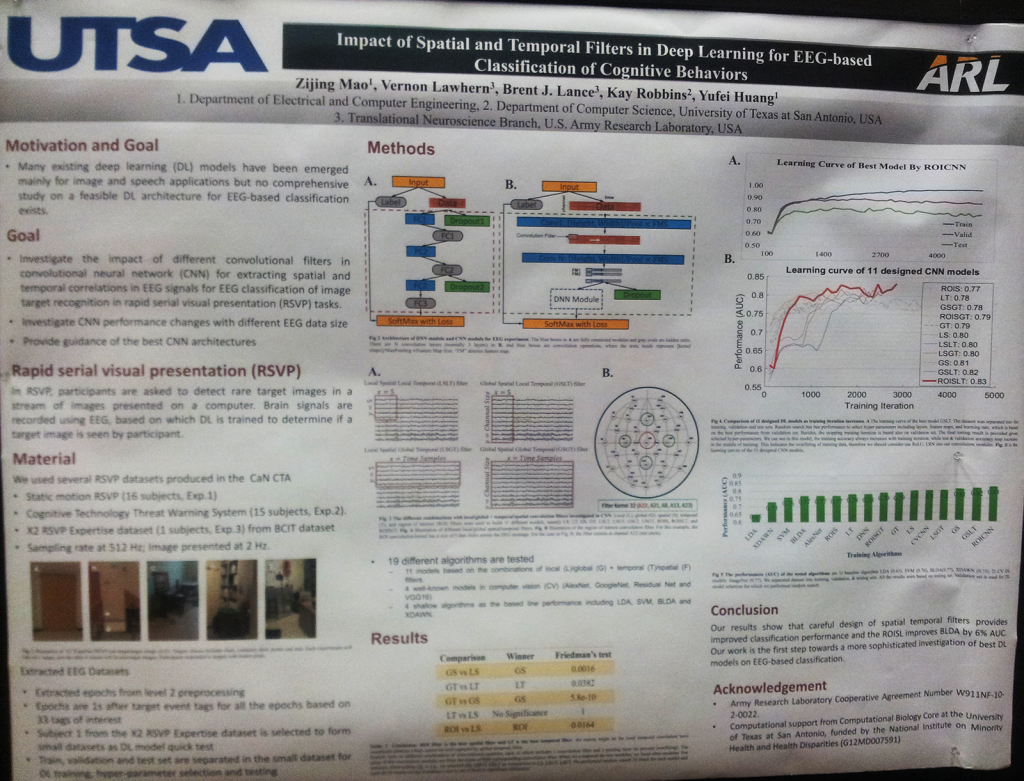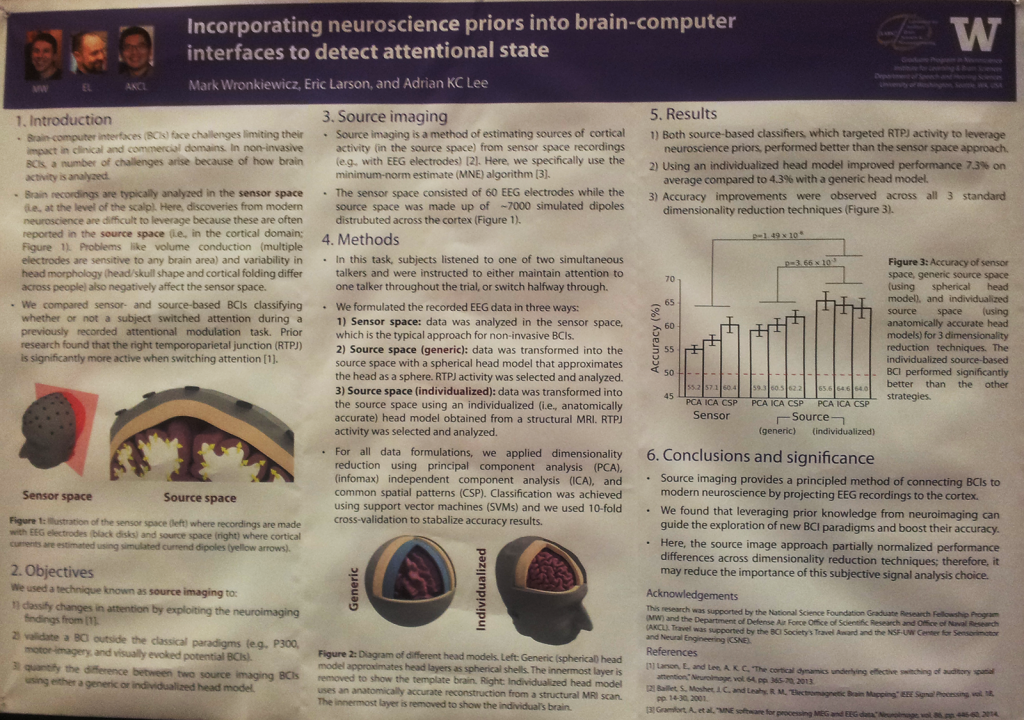
Notes on BCI Meeting 2016
I had two personal goals for attending BCI Meeting 2016:
- Present my poster, gather feedback and look for contacts with whom the idea presented on the poster might be tested on intracranial devices.
- Figure out if there is a future for BCI beyond its medical applications.
Disclaimer: this post contains mostly the observations that are important to me and does not present full overview of the conference. All of the observations, comments and conclusions are biased by my personal research interests and goals. The notes under the presentation and posters below might not reflect the content of the presentation, but rather the thoughts I had while listening.
Day 1
Eb Fetz, Emanual Donchin, Jon Wolpaw
History and Future of BCI
- Historical overviews, predictions
- [!] BCI reliability is much lower than it has to be in order to push BCI-based tech to masses
Talked with Jon Wolpaw and confirmed that the idea to fix accuracy at 99.9% and work on reducing data transfer time makes sense and might be a viable path towards more reliable BCIs.
Day 2
State of BCI
| Nick Ramsey BCI for Communication Very convincing presentation about how BCI is helpful as a communication channel for ALS patients. EEG-based systems loose to other alternative methods (such as an eye tracker) and thus the trend presented in this talk was towards invasive implants. |
Lee Miller BCI for Control It seems that all of the important achievements will be made with the invasive methods — intracranial studies seem to tackle bolder theories and in case of success might lead to novel discoveries. Meanwhile the EEG-based research seems to be stuck at tuning P300-based applications, marginal improvements of performance. Those things are important for practical applications, but are less promising for basic research. |
|
Aaron Batista BCI for Basic Research This branch of BCI is closest to neuroscience, it deals with the ways how BCI methods can be used in order to ask and answer questions about the brain and neural dynamics. |
Jose del R. Millan BCI for General Population Quite random talk about several use cases where BCI technologies are used in non-medical applications. All of the ideas presented here raised the same question in my head — “why not to do it with other, non-BCI methods, which work much better?”. My hopes for a fascinating non-medical application of BCI were thrown off by this talk. |
Virtual Forum of BCI Users
Actual users of BCI talked about their experiences and hopes.
Short talks
| Jason Farquhar Imagined vs. attempted movement in BCI Movement attempt provides stronger signal than movement imagination and thus should be used in BCI applications. |
Wei Wu Audiovisual BCI for awareness detection Audiovisual setup provides stronger P100, N200 and P300 responses than a unimodal condition (video only or audio only). |
Damien Lesenfants Idle state detection in intracortical BCI Two Utah arrays to control a cursor movements and clicks — work impressively well. The question to solve is how to detect the times when the subject does not want to interact with the system at all. |
| Bryan Baxter [!] BCI with simultaneous transcranial direct current stimulation Visual feedback is not enough to interact with the objects. Stimulation in primary somatosensory cortex may elicit tactile sensation. Finger of a robotic arm is pushed and with 84% accuracy the test subject reports which finger that was. Stimulation is with fixed strength and not continuous, so it is just a first step. |
Benjamin Dann Separable decoding of visual, intention and movement information Functionality of different modality seems to be distributed over neurons. Is it not the case that each type of activity has its own coding neurons. |
Mahnaz Arvaneh Improving Memory using BCI Identify the items that are poorly encoded in memory. Successfully remembered items are correlated with increased frontal theta activity, decrease in occipitoparietal alpha and some other features. Tried to train a classifier to predict whether each particular word-stimulus will be remembered or forgotten. Classifier was at chance level, but some statistical traits seem to be present. |
From these presentations I got the feeling that machine learning has achieved the level, where usable tools are available to non-specialists. This means that the role of a machine learning scientist is now shifting back from helping scientists in other areas to basic theoretical research.
Is there any future for BCI systems where a random mental activity is associated with an action? Probably not, because such systems do not allow for continuous input (to perform an action with varying intensity) and the activity the user should perform is not intuitive (thinking about apples to move the cursor to the left). Thus it seems that an abstract mental state classification is not useful for control in BCI. Might still make sense in other areas of BCI, such as mental state exploration and general neuroscience/psychology research.
Poster session I
I was too busy presenting my own work and had little time to look at other posters. My poster elicited lots of interest and lots of positive feedback. The end goal would be to find an intracranial lab where I would be able to try my real-time system on patients with implanted electrodes.
Day 3
Workshop: Technological Implant Developments
The workshop was about implantable devices and associated research. Bunch of implantable devices presented. One was portable and coupled with a tablet, another was presented as a multiple-purpose general implantable solution for BCI or Parkinson’s. W-HERBS: 128ch ECoG in development, subdural placement, goal is to control a robotic hand. CLINATEC, CEA Biomedical Research Center, France presented their ECoG implant that replaces part of the scull. The next stage for them is to use it to control an exoskeleton.
Poster sessions II & III
Eberhard Fetz: Recent applications of closed-loop BCI
They’ve built the “Neurochip” device, that reads the signal, processes it and can provide electrical stimulation. Can be used for:
- artificial recurrent connection: brain could learn to use this new connection to replace a missing one to resotre function (spinal cord injury, cognitive function if part of brain is damaged)
- creating synaptic plasticity: experimental results showing decrease/increase (using STDP rules) of synaptic strength in a monkey and an experiment on rats, where their reaching ability was impared and then (partially) restored using neurochip and target-dependent plasticity training
- reinforing some activity by stimulating reward center automatically and then study learning
Future plans include tracking changes in plasticity, [!] simulate an artificial neural network and connect it with biological neural network via those loop connections. [!] Sci-fi prognosis is that brain could learn to use computational possibilities on a chip.
Day 4
Workshop: Exploiting cognitive processes for BCI
Dedicated to the search of other P300-like signals, that reflect some inner workings on the brain.
Workshop: Algorithms and performance using implaned devices
The area of decoding in implanted devices heavily relies on machine learning methods like ReFIT, Kalman Filters and even HMM and Neural Nets were mentioned. The most impressive system that was demonstrated enabled the user to operate an Android tablet using a coursor movements + “click” command. The device is one Utah array. I was impressed by the speed of performance — I would say that the patient was able to operate the device only 3 times slower than I do (of course large part of it comes from limited capabilities of android input methods, making it perfect for coursor + click way of operating it).
Workshop: Deep Learning, other ML & signal processing for analysing EEG in BCI
| Dean Krusienski Overview of Signal Processing for BCI SMR, CSP, P300 peak is rarely visible from a single trial, SSVEP, ECoG provides very reliable signal in gamma band for number of applications. |
Yalda Shahriair Brain connectivity analysis in patients with neurological impairments |
Damien Coyle 3D hand movement velocity reconstruction from EEG |
| Chuck Anderson Convolutional Neural Networks Look at EEG data as 2D “image” — channels x time. Convolve over time, space or both. |
Elliot Forney EEG signal classification with convolutional networks on mental task paradigms. Very nice python notebook presentation showing performance of difference methods on same small EEG dataset with 4 classes.
The dataset is available here. |
Nick Waytowich Analysing EEG with Convolutional Neural Networks One of the problems in applying DL to EEG data is small amounts of data. They applied CNN to five different datasets (different paradigms) to try to find one archiecture will perform reasonably well without handcrafting. And it does perform reasonable well, but not as good as a per-dataset specific handcrafted method would. [!] They also got to the idea to take all possible EEG out there and train one feature extractor on all of it. |
Conclusions
- Invasive is the way for basic research.
- Other-than-medical applications are not clear — the are some, but all of them seem marginal.
- Machine learning became a tool — enough ready-to-use products for a non-specialist to apply it successfully.
- Deep Learning had a promising start, but no groundbreaking results so far.



No comments yet.